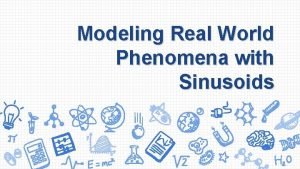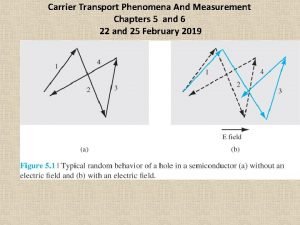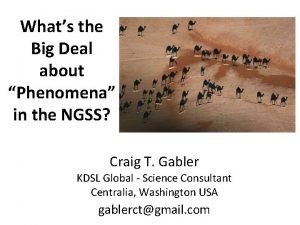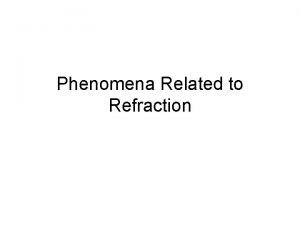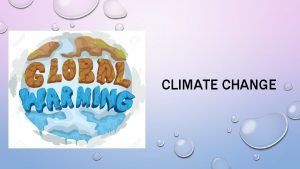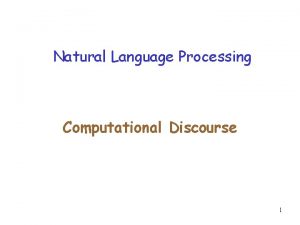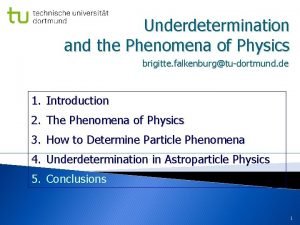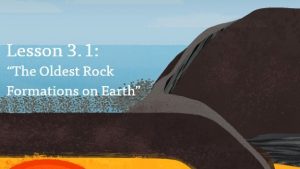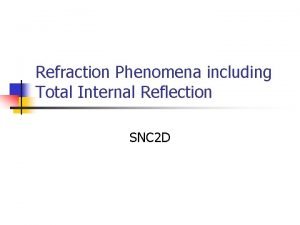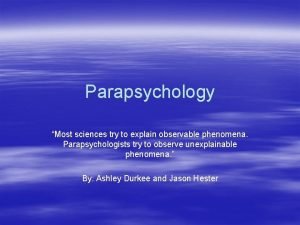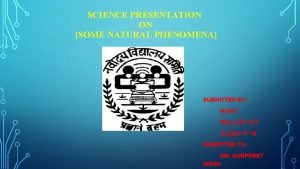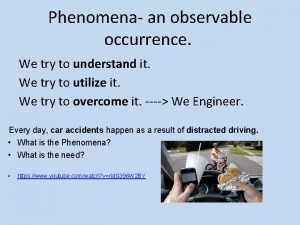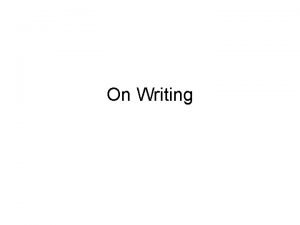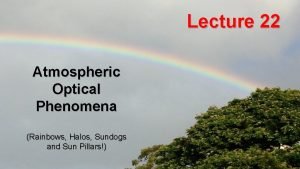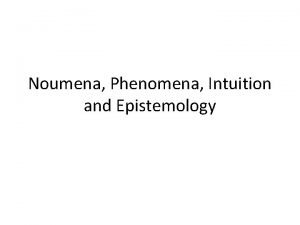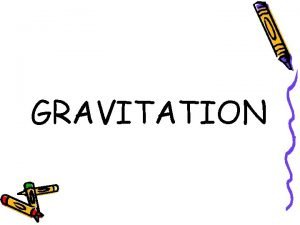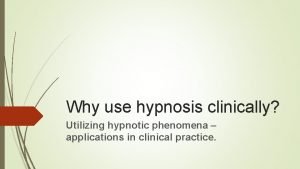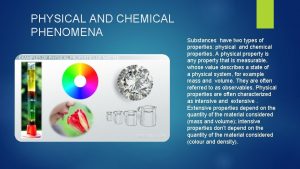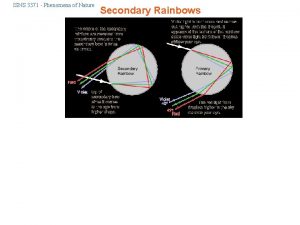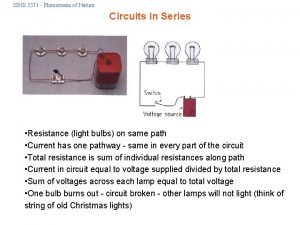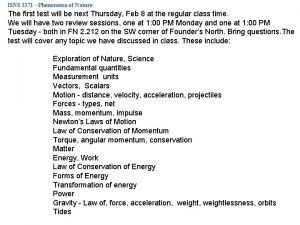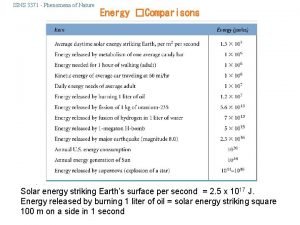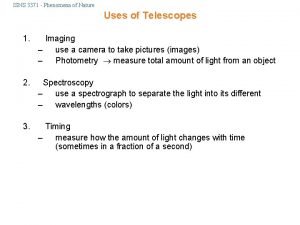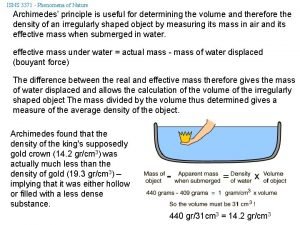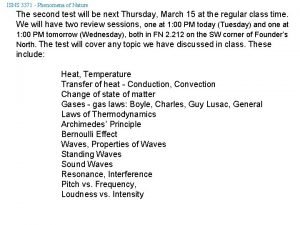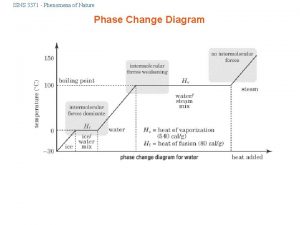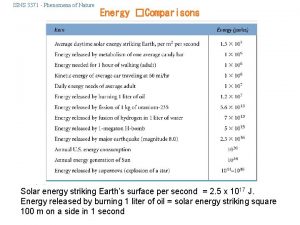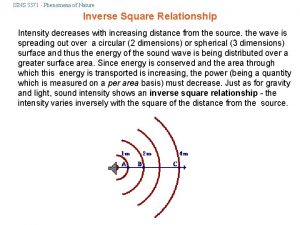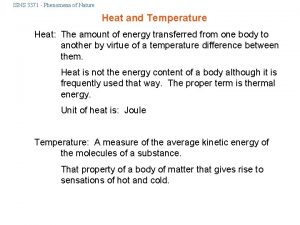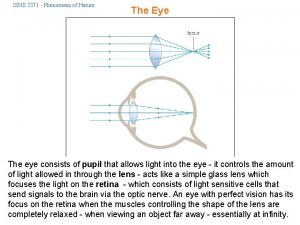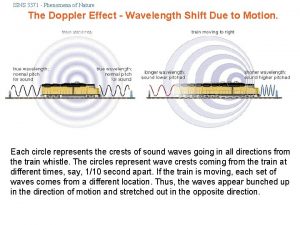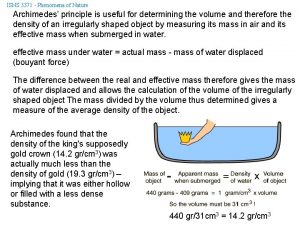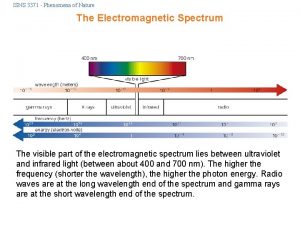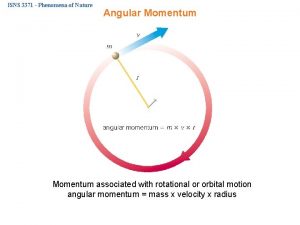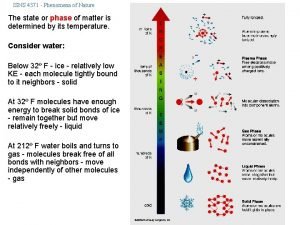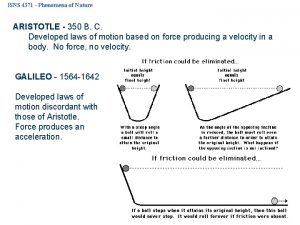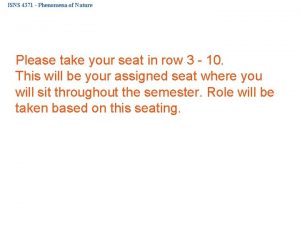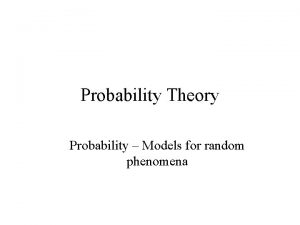ISNS 3371 Phenomena of Nature The final will






















- Slides: 22

ISNS 3371 - Phenomena of Nature The final will be Tuesday, April 24 at 8: 00 AM. NOTICE THE TIME! We will have two review sessions following the class on Thursday in the lab at the far west end of Founders North. One from 11: 00 - and the other from 2: 00 - ? . The test will cover any topic we have discussed in class and will be approximately 40% comprehensive and 60% on what we have covered since the last test. Topics include: Fundamental quantities Measurement units Vectors, Scalars Motion - distance, velocity, acceleration, projectiles Force Mass, momentum, impulse Newton’s Laws of Motion Law of Conservation of Momentum Torque, angular momentum, conservation of angular momentum Matter - States of Matter Energy, Work Law of Conservation of Energy Forms of Energy

ISNS 3371 - Phenomena of Nature Transformation of energy Power Gravity - force, acceleration, weightlessness Heat, Temperature Transfer of heat - Conduction, Convection Change of state of matter Gases - gas laws: Boyle, Charles, Guy Lusac, General First Law of Thermodynamics Archimedes’ Principle Bernoulli Effect Waves, Properties of Waves Standing Waves Sound Waves Resonance, Interference Pitch vs. Frequency, Loudness vs. Intensity Beats Resonance in open and closed pipes Harmonics Doppler Effect

ISNS 3371 - Phenomena of Nature Light as a wave, particle Photoelectric effect Electromagnetic Spectrum - Color Light interaction with matter Refraction, Reflection Scattering - Blue Sky - Red Sunsets Rainbows Polarization Lenses and mirrors Telescopes Spectroscopy - emission and absorption spectra Thermal radiation/black body spectrum Doppler effect - rotation, extrasolar planets Electrical charge, voltage, current, power Electrical circuits (parallel and series), resistance Ohm’s law AC and DC current Magnetic fields, moving charges, right-hand rule Induction, Faraday’s law Motors and generators Lenz’s law

ISNS 3371 - Phenomena of Nature Voltage Electric potential - change in electric potential is work done on charge by an electric (Coulomb) force. Remember: work = force X distance (over which force is applied) Analogous to gravitational potential energy: work done by the force of gravity in moving a mass through a certain distance Units of voltage are Volts (Joules/Coulomb). In a nine volt battery the potential difference between the positive and negative terminals is precisely nine volts.

ISNS 3371 - Phenomena of Nature Current Establish a potential difference between two points and release some charges - charges will be acted on by the electrical force and start to move this is a electric current - a flow of electrical charges. Just like the flow of H 2 O is a water current. A current is the amount of charge that flows by a given point in a certain time interval. Unit is Ampere (A = Coulombs/second) In electrical circuits, consist of electrons in the wire moving from lower to higher electrical potential. By convention, electrical current flows from positive to negative - electrons flow in opposite direction. In other words, a positive current flows from higher to lower electrical potential.

ISNS 3371 - Phenomena of Nature Resistivity and Circuits If a wire is connected between two poles of a battery, a current flows. This is a circuit. The electrons do not move completely freely - there is a resistance to their flow - has to do with number of collisions electrons make with other electrons and atoms. Amount of current dependent of resistivity. Unit of electrical resistance is Ohm ( ). Insulator - high resistivity Conductor - low resitivity Superconductor - zero resistivity Dependent on material, temperature, length of wire Electrical circuit like hydraulic circuit with flow of water analagous to flow of electrons.

ISNS 3371 - Phenomena of Nature Power is the rate of energy flow. Unit is Watt ( Watt = Joules/second) Power = Voltage X Current - 1 W = 1 VA Total amount of energy used = Watt X Time, This is how the power company charges us for electricity - by the kilowatt hour (k. Wh) The power rating of an appliance tells us the rate at which it uses electrical energy. For example, a 1500 watt hair dryer uses 1500 joules of electrical energy per second. Keep a 60 watt light bulb on for a full day: uses 60 watts x 24 hours = 1440 watt hours = 1. 44 kilowatt hours of energy. At 9 cents per kilowatt hour this would cost just under 15 cents. kilowatt hour is a unit of energy - can convert it to joules: 1. 44 k. Wh = 1440 J/s X 3600 s = 5, 184, 000 J

ISNS 3371 - Phenomena of Nature Electrical Quantities QUANTITY SYMBOL UNIT MEANING Charge Q Coulomb (C) A basic property of some elementary particles. The electron has a charge of -1. 6 X 10 -19 C and the proton has a charge of +1. 6 X 10 -19 C Current I Ampere (A) (1 A = 1 C/sec) Rate of flow of charge. Potential Difference (voltage) V Volt (V) (1 V = 1 J/C) J= Joule Potential energy difference per coulomb of charge between two points; corresponds to pressure in water flow.

ISNS 3371 - Phenomena of Nature QUANTITY SYMBOL UNIT MEANING Resistance R Ohm (Ω) 1Ω = 1 V/A A measure of the opposition to the flow of charge in a particular circuit. For a given voltage, the higher the resistance, the lower the current. Power P Watt (W) (1 W = 1 Vx. A) Rate of energy flow.

ISNS 3371 - Phenomena of Nature Ohm’s Law states that the amount of current in a circuit is proportional to the voltage across the circuit and inversely proportional to the resistance in that circuit I=V/R or V = IR Voltage = Current x Resistance

ISNS 3371 - Phenomena of Nature Electrical Shock “It’s not the voltage but the current. ” The current is what actually causes a shock - human body has resistance of ~500, 000 with dry skin - ~100 wet! Requires conducting path. Can cause: (1) burning of tissue by heating, (2) muscle contractions, (3) disruption of cardiac rhythms. Current (A) Effect 0. 001 Can be felt 0. 005 Is painful 0. 010 Causes spasms 0. 015 Causes loss of muscle control 0. 070 Goes through the heart - fatal after more than 1 second

ISNS 3371 - Phenomena of Nature Circuits in Series • Resistance (light bulbs) on same path • Current has one pathway - same in every part of the circuit • Total resistance is sum of individual resistances along path • Current in circuit equal to voltage supplied divided by total resistance • Sum of voltages across each lamp equal to total voltage • One bulb burns out - circuit broken - other lamps will not light (think of string of old Christmas lights)

ISNS 3371 - Phenomena of Nature Water Analogy for Series Circuits

ISNS 3371 - Phenomena of Nature Parallel Circuits • Bulbs connected to same two points of electrical circuit • Voltage same across each bulb • Total current divides among the parallel branches equals sum of current in each branch - current in each branch inversely proportional to resistance of branch • Overall resistance of circuit lowered with each additional branch • Household wiring (and new Christmas light strings) designed in parallel - too many electrical devices on too much current - trip fuse/breaker

ISNS 3371 - Phenomena of Nature Water Analogy for Parallel Circuits

ISNS 3371 - Phenomena of Nature AC vs DC Current Direct Current (DC) - electricity that you get from batteries - current (movement of electrons) flows in one direction - from positive (high potential) to negative (low potential) - note: electrons actually flow from negative to positive. Alternating Current (AC) - electricity that comes from the wall plug in your home - current alternates in direction flowing first one way then the other - electrons move back and forth in wire

ISNS 3371 - Phenomena of Nature System of AC electricity in the US cycles the current from positive to negative and back to positive 60 times a second - 60 Hz. Standard household wiring design has two 120 volt "hot" wires and a neutral which is at ground potential - two 120 volt wires are obtained by grounding the centertap of the transformer supplying the house so that when one hot wire is swinging positive with respect to ground, the other is swinging negative - allows the use of either hot wire to supply the standard 120 volt household circuits. Major advantage of AC over DC - AC voltages can be transformed to higher or lower voltages. - high voltages used to send electricity over great distances from the power station can be reduced to a safer voltage for use in the house - higher voltage in transmission means less loss of power

ISNS 3371 - Phenomena of Nature Magnetism

ISNS 3371 - Phenomena of Nature The situation with forces due to magnetism is more complicated that electrical/Coulomb forces. -despite numerous searches, no evidence of magnetic charges exist. In other words, there are no particles which create a radial magnetic field (usually termed monopoles by physicists) in the way an electric charge creates a radial field. Regions called magnetic poles produce magnetic forces - a north magnetic pole never exists without a south magnetic pole - together called a dipole As for charges - like poles repel and opposite poles attract. Cutting a magnet in half will not isolate a single north or south. One magnet becomes two, then four, and so on.

ISNS 3371 - Phenomena of Nature Magnetic fields can be created by moving electric charges, i. e. currents produce fields. Follows right-hand rule: point thumb of right hand in direction of current magnetic field curls around wire in direction of curled fingers If the current flows in a loop, the magnetic field produced is like a bar magnetic - curl fingers of right hand in direction of current flow - north pole is in direction of thumb.

ISNS 3371 - Phenomena of Nature The electron spins on its axis, giving rise to a electron current in the direction of rotation. The electron is like a magnetic dipole, a miniature magnet, with a north end a south end. In most substances, electrons spin in random directions - magnetic fields cancel. For iron and other magnetic substances, the spin magnetism is not canceled. Can be permanently magnetized by placing in strong magnetic field and permanently aligning atoms - can be demagnetized by dropping magnet and jostling atoms out of alignment. Electromagnetic produced by wrapping coil around iron bar - magnetic field produced that aligns atoms in bar - more coils or more current - larger magnetic field and greater atomic alignment

ISNS 3371 - Phenomena of Nature Induction There is amazing reciprocity in nature - if moving electric charges create magnetic fields, then magnetic fields must exert forces on moving electric charges, just as electric charges create and are ``acted upon by'' magnetic fields. Force is perpendicular to magnetic field and direction of motion. Leads to the induction of current in a wire moved through a magnetic field - or a magnetic field moved past a wire Pass a magnet through a coil of wire - produce a current Faraday’s Law - The induced voltage in a coil is proportional to the number of loops multiplied by the rate at which the magnetic field changes within those loops.
 Police academy nes
Police academy nes Real world phenomena
Real world phenomena Carrier transport phenomena
Carrier transport phenomena Noumena vs phenomena
Noumena vs phenomena Phenomena related to refraction of light
Phenomena related to refraction of light Global climate phenomena
Global climate phenomena Reference phenomena in nlp
Reference phenomena in nlp Brigitte falkenburg
Brigitte falkenburg Phenomena yksikkö
Phenomena yksikkö Anchor phenomena
Anchor phenomena What is critical angle
What is critical angle Observable phenomena psychology
Observable phenomena psychology Random phenomena
Random phenomena Examples of colloids
Examples of colloids Slidetodoc. com
Slidetodoc. com Class 8 some natural phenomena ppt
Class 8 some natural phenomena ppt Observable phenomena
Observable phenomena Objective consideration of contemporary phenomena
Objective consideration of contemporary phenomena A rainbow is an optical display
A rainbow is an optical display Noumena and phenomena
Noumena and phenomena Gravitational phenomena
Gravitational phenomena Hypnotic phenomena
Hypnotic phenomena Physical and chemical phenomena
Physical and chemical phenomena

